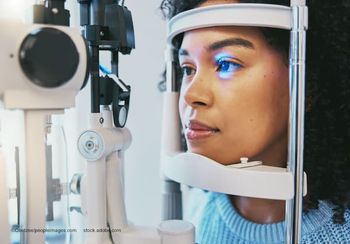
Fixed-combination therapies are compared in studies
Pooled results from two randomized, investigator-masked parallel group clinical trials show that the fixed combination fo brimonidine tartrate 0.2%-timolol maleate 0.5% produced greater IOP lowering than the fixed combination of dorzolamidehydrochloride 2%-timolol maleate 0.5%, whether the fixed combination products were used alone or as an adjunct to treatment with a prostaglandin analogue.
Barrie, Ontario-Pooled results from two randomized, investigator-masked parallel group clinical trials show that the fixed combination of brimonidine tartrate 0.2%-timolol maleate 0.5% (Combigan, Allergan) produced greater IOP lowering than the fixed combination of dorzolamide hydrochloride 2%-timolol maleate 0.5% (Cosopt, Merck), whether the fixed-combination products were used alone or as an adjunct to existing treatment with a prostaglandin analogue, said Donald R. Nixon, MD.
The studies included 180 adult patients with open-angle glaucoma or ocular hypertension enrolled at 10 investigational sites, according to Dr. Nixon, director, Trimed Eye Center, Barrie, Ontario, and lead author of the published paper reporting the study results [Curr Med Res Opin 2009;25:1645-1653]. Participants could be either naïve to previous treatment or needed further IOP lowering on existing therapy, and they were randomly assigned to twice-daily treatment with one of the two fixed-combination products. IOP measurements were obtained at peak effect (10 a.m.), and the primary efficacy analysis was based on mean change in IOP after 3 months.
For patients using the fixed combination as monotherapy, the mean IOP reduction from baseline to 3 months was 7.7 mm Hg (32.3%) in the brimonidine-timolol group and 6.7 mm Hg (26.1%) among dorzolamide-timolol users (p = 0.040). When used as adjunctive treatment, brimonidine-timolol was associated with a 6.9 mm Hg (29.3%) lowering from baseline IOP, while patients using dorzolamide-timolol achieved a 5.2 mm Hg (23.5%) reduction (p = 0.213), Dr. Nixon said.
"Although numerically the difference in IOP-lowering between fixed-combination treatment groups was even greater in the adjunctive therapy subgroup versus the monotherapy subgroup, there were fewer patients being treated with adjunctive therapy," he said. "Therefore, this study may not have had sufficient power to detect a statistically significant difference between the two adjunctive treatment groups.
"However, in a previous review by Anne Coleman, MD (Coleman, et al, in: Managing Glaucoma: The Current Clinical Strategies. 2003), she felt that an effective adjunctive therapy should provide at least 15% to 20% further lowering of IOP," Dr. Nixon said. "On that basis, the 29% reduction achieved with brimonidine-timolol indicates it is an excellent choice for adjunctive therapy, which is also the most common role for use of a fixed-combination product."
There were no significant differences between treatment groups in their baseline characteristics. Overall, the study population had an average age of about 68 years, was predominantly Caucasian (92%), female (56%), and had a diagnosis of open-angle glaucoma (~85%). A majority of patients (56%) was treated with the fixed-combination product as monotherapy, and about 70% of those patients used it as a substitute for prior therapy. Within the adjunctive treatment subset, there were no significant differences between the two fixed-combination groups with respect to use of the various prostaglandin analogues.
There also were no statistically significant differences between treatment groups in baseline IOP. For the monotherapy patients, mean baseline IOP was 23 mm Hg in the brimonidine-timolol group and 23.6 mm Hg in the dorzolamide-timolol group. Corresponding values in the adjunctive treatment group were 21.9 and 21 mm Hg, respectively.
The study also investigated comfort and tolerability using a questionnaire administered after 1 month. The results showed that patients using brimonidine-timolol reported significantly less burning, stinging, and unusual taste compared with the group treated with dorzolamide-timolol (p < 0.001 for all comparisons). For all of these adverse effects, mean scores were <1 (very minimal) in the brimonidine-timolol group and ranged between 1.2 and ~2 (mild) in the dorzolamide-timolol group.
Patients comfortable
"Overall comfort ratings also showed a statistically significant difference favoring brimonidine-timolol with the proportion of patients rating their study treatment as 'very comfortable' being about twofold higher in the brimonidine-timolol group compared with the dorzolamide-timolol users, 41% versus 21%," Dr. Nixon said.
"The better safety profile of brimonidine-timolol in this study has implications for medication compliance, which remains one of the biggest obstacles in management of ocular hypertension and glaucoma," he said. "Perhaps greater comfort might have resulted in increased compliance for patients in the brimonidine-timolol group, which could have contributed to its greater IOP-lowering effects."
A post-hoc analysis of the study data conducted by Eve Higginbotham, MD, investigated incremental cost-effectiveness of the two fixed combinations. The results showed that the proportion of patients achieving IOP thresholds between <12 and <17 mm Hg was consistently about 20% higher in the brimonidine-timolol group compared with the dorzolamide-timolol group, resulting in a statistically significant incremental benefit for the brimonidine-timolol group within that IOP range.
Newsletter
Don’t miss out—get Ophthalmology Times updates on the latest clinical advancements and expert interviews, straight to your inbox.


















































.png)


